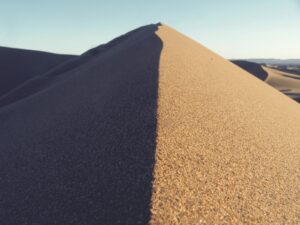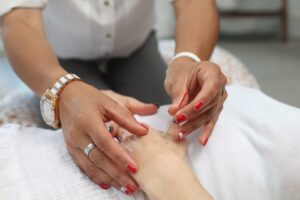Subscribe to the Newsletter
If you are interested in understanding how Traditional Chinese Medicine can improve your life sign up to my newsletter for the latest updates.

Knee pain affects apparently 25% of us … so drug manufacturers love it!
Every drug you take must be metabolised by your body, slowing it down. Some drugs have unpleasant side-effects for which you may be taking additional drugs!
You have two knees and they’re built strong but hard to repair when one goes wrong. Look after them carefully! However, Chinese medicine and acupuncture have lots to offer.
This page looks at knee pain from the point of view of Chinese medicine: I’ve simplified a complicated subject, so please don’t think that what you read here is all there is to say!
Mention knee pain to acupuncturists and most will instantly think of one particular cause even though it’s not usually the most common except in old people. And not everyone is old! So let’s get that one out of the way!
Older people have walked further than younger people. Age uses up their jing essence. They notice age-related deficiencies in their backs and knees. What kind of knee pain is this?

I treat many people in their 70s and 80s, and a few into their 90s. Many have knee pain, and acupuncture is often highly effective, preventing recurrence of the pain for some months unless the patient gets over-exhausted (by which I mean that, after strain or stress, their energy doesn’t improve even after several nights of good sleep).
However, the patient usually needs an acupuncture treatment every few months to maintain improvement. They are usually happy with this arrangement because treatment helps them feel better in many other ways – not just in their knees!
For kidney deficiency, there are also Chinese herbal formulae. The exact formula depends on your symptoms, not least on whether you are more Kidney Yin or Kidney Yang deficient, but all the formulae start with then adapt to your particular circumstances liu di huang wan.

This knee pain is common, at least in cold, wet climates. Modern advice for ice for knee (and other) trauma is, well … wrong! Ice helps pain and inflammation short term but is poor advice for long-term knee health because ice is cold, and damp easily ‘invades’. What are the symptoms?

Knee pain from Cold is more common as you age, because with age comes poorer circulation so you get cold more easily. (Especially if you are Kidney yang deficient.) Lacking internally generated warmth your body is less good at repelling external ‘evils’ like Cold.

This comes from what Chinese medicine calls ‘stagnation’, or ‘stasis’. (Stagnation refers to Qi, Stasis to Blood.) Although there’s much more to it than this, Blood stasis often follows Qi stagnation, which itself has many causes, the main one being emotional tension from Stress and Frustration.
Pain occurs because of what Chinese medicine calls a blockage in the flow of energy and blood through the joint.
Accidents and sudden trauma initially block the flow of Qi, then because Qi stagnates, you get soon get Blood stasis: the shock leads to bruising. Repeated movements of any joint can also cause this syndrome.
Examples include:

This kind of pain comes from trauma, overstrain or repetitive strain, so

Stay in Touch!
No spam, only notifications about new articles and updates.

Book a Video consultation if you want to know more about your symptoms
Damp-Heat symptoms often look infected, and they may be. But in Chinese medicine, the symptoms you get might NOT be due to infection.
You can probably understand that if there is both damp and heat, infection readily finds a welcome. There are benefits from living in cold climates – not so many bugs and bacteria! As you approach warmer climates you get more of both. So when your body harbours Damp-Heat it may become more vulnerable to infection.
Damp-Heat is a big subject – we’ve got a page on it, worth reading if you think your knee pain comes from it there may be things you can do to reduce your predisposition to it.

If the Damp-Heat penetrates further into your system you get more general symptoms, such as

If you or your acupuncturist can identify which acupuncture channels are affected, treatment will be more effective and work faster.
Channel theory is a big subject and it seems simple when you start! Treating the affected channel is important, but your acupuncturist will get even better results if, when treating the actual channel identified, s/he also treats points on the same name channel on the arm. For example, if your pain is on the Spleen channel, the foot tai-yin channel, consider points on the arm tai-yin channel, the Lung channel. For knee pain, such points might be around the elbow.
Also use, of course, acupuncture points for the particular syndrome diagnosed. For Damp, for example, consider Spleen 9.

This Introductory Chinese medicine course introduces you to the amazing thinking behind this ancient medicine, now increasingly in demand.

The Scottish College for Chinese medicine provides introductory courses for all, explaining Chinese medicine and its cultural background.

Master Tung’s acupuncture is a hidden treasure, lost to China but recovered in Taiwan from where it spread round the world.

Knee pain has five main causes. It’s certainly worth trying acupuncture before you resort to surgery!
Subscribe to the Newsletter
If you are interested in understanding how Traditional Chinese Medicine can improve your life sign up to my newsletter for the latest updates.
Subscribe to the Newsletter
If you are interested in understanding how Traditional Chinese Medicine can improve your life sign up to my newsletter for the latest updates.